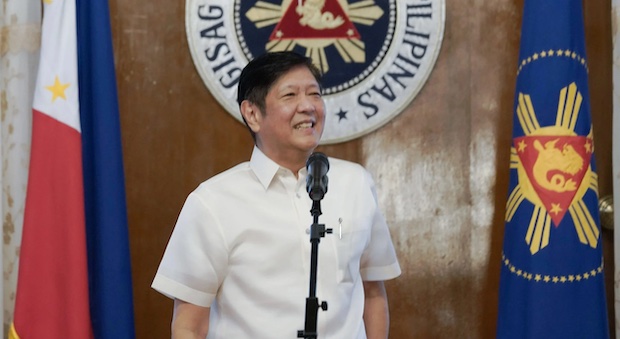Palace: Revamp up in agricultural agencies

President Ferdinand Marcos Jr. (MALACAÑANG FILE PHOTO)
President Marcos announced on Wednesday an unspecified revamp in unidentified agricultural agencies in a bid to boost rice production and even attain rice self-sufficiency in two years.
The President did not specify what agencies would be affected when he mentioned the revamp in a meeting with officials of the Department of Agriculture (DA) and the National Irrigation Administration (NIA) in Malacañang.
“From that discussion, we have begun to put in the timetable of what are the things that we need to do,” he said in a statement released by the Presidential Communications Office.
“And in our calculation, if we can do everything that needs to be done because we have a lot to fix, we will have to reorganize a lot—but if we can do all that, we will be close to self-sufficiency for rice in two years,” he said.
According to him, the government has “a great deal of work to do,” adding that there has to be a “cooperation, convergence and coordination” with other agencies, such as the DA, NIA, Department of Public Works and Highways, and the National Economic and Development Authority.
Article continues after this advertisement“So our next meeting will be that. All the concerned agencies are there and we will present the timetable as to what needs to be done, what forms of coordination need to be done,” he said.
Article continues after this advertisementDuring the campaign period last year, Mr. Marcos promised to lower the price of rice to P20 per kilo, but he later admitted that it won’t be easy.
After he was named to the Marcos Cabinet, veteran agriculture official Domingo Panganiban, who previously served as senior agriculture official to three presidents, affirmed that it was possible to lower the retail price of rice.
Short supply of rice
But that was before the Russia-Ukraine war which jacked up the prices of fertilizer and fuel in addition to the devastation wreaked by avian flu and African swine fever (ASF).
The DA earlier estimated that, for 2023, the country will be in short supply of rice by more than 3 million metric tons (MT) this year due to high production costs and the country is expected to import up to 3.8 million MT to meet the shortfall.
Aside from rice, the DA also expected a continuing shortage of pork because the country’s hog population was reduced from 12 million to 9 million because of ASF and it will take at least five years to repopulate the national inventory.
In his meeting with rice industry stakeholders on Tuesday, the President agreed to adopt hybrid rice as a better alternative to the inbred variety for increased crop production.
In a statement late Wednesday, Presidential Communications Secretary Cheloy Velicaria Garafil cited that the government had the Rice Competitiveness Enhancement Fund (RCEF) program, created under Republic Act No. 11203, or the Rice Tariffication Law, “to improve the competitiveness of farmers amid the liberalization of the rice trade policy.”
“To complement the RCEF, the government has been implementing strategies to increase rice production, such as convincing irrigators associations and farmers to plant hybrid rice seeds, adopting alternate wetting and drying as a water-saving technology for irrigated lands, harvesting in September during the wet season, and ratooning after harvesting during the wet season,” Garafil said.
Irrigation projects
Garafil also said that the NIA has been implementing several measures to develop the Philippine irrigation infrastructure.
Among the NIA strategies, she said, include public-private partnerships on irrigation infrastructure development, climate-proof infrastructure, flood control management and massive reforestation of NIA-supervised watershed areas.
She said the NIA has a total investment pledge of more than P1 trillion from potential private partners, which would allow it to pursue its irrigation projects without the restriction of limited funding.
As of Dec. 31 last year, she said that only 2.04 million hectares (ha), or 65 percent of the country’s potential irrigable area of 3.13 million ha, had water, benefiting around 1.5 million farmers.
However, around 1.09 million ha, or 35 percent of the remaining areas, still need to be irrigated, Garafil said.